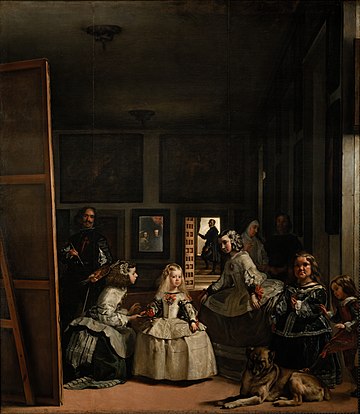I’d call this large painting the highlight of the Goya exhibition at Boston’s Museum of Fine Arts:

Goya depicts himself at the bottom left, painting the Spanish nobleman Luis de Borbón and his family in 1784. Don Luis was a brother of the king who had been sentenced to internal exile for being both a liberal and a libertine. A patron of the arts, he is here depicted with the painter Goya and probably the composer Boccherini, along with his wife, children, and other friends or retainers. The atmosphere is casual, cheerful, and warm. The infante’s wife is shown with her hair down; Don Luis is playing cards; the standing man near the right grins at us; and one of the children is curious in a friendly way about what Goya is doing.
“La Familia del infante Don Luis” must be compared to two other paintings. In “Charles IV and His Family” Goya depicts the monarch and a large retinue visiting his studio. Goya stands in the back behind a large canvass that he is working on. The royal family is dressed formally and splendidly and stands stiffly for an official portrait. The color scheme is cold; the image is crisp and precise; the air is oppressive.
These two family portraits (that of the king and of his brother) are both replies to the most famous work of art in Spain, “Las Meninas” (1656), in which Velasquez depicts some members of the royal family visiting his studio while he works on a canvass.

The precise topic of “Las Meninas” is controversial (see this post). The faces of the King and Queen of Spain appear in the mirror behind Velazquez. The mirror could show the painting he is working on, in which case he is touching up a royal portrait while the princess and her servants visit his studio. Or the real King and Queen could be visiting, standing where a viewer stands to see “Las Meninas.” In that case, we have no way of knowing what is depicted on the canvass, but it could be “Las Meninas” itself, which is a portrait of the royal princess and her attendants. Then, on the canvas in front of him, Velazquez would also appear–painting Velazquez, painting Velazquez, painting Velazquez, in a mise-en-abime. On my blog, Colin Dexter once proposed that Velazquez and everyone else in the picture is staring into a mirror set up where we stand, so that the artist can depict himself.
In any case, “Las Meninas” is remarkably three-dimensional, almost like a Vermeer in its uncanny realism. It is ambiguous and complex, with mirrors, paintings within paintings, people looking at people who look at us: an image about images. It is historically significant, marking a moment at which the genius-artist becomes a peer of royals. And it is “iconic,” immediately recognizable thanks to many famous critical essays, reproductions, and replies (e.g., Picasso’s “Las Meninas” series), of which Goya’s are just two.
I presume that the differences between “Las Meninas” and “La Familia del infante Don Luis” are intentional on Goya’s part:
- “Las Meninas” looks magically “real.” Goya’s painting is matte and sketchy, happy to look like a painting (even though Goya was capable of more polish, as in “Charles IV and His Family”)
- Velazquez is dashing and distinguished, a courtier from the Age of Absolutism. Goya is informal and comfortable, representing the Age of Reason.
- Velazquez is painting a massive baroque work, which we cannot see at all. Goya is working on a painting of modest size that would belong in a drawing room.
- Velazquez stares at us, but we cannot see his work. Goya stares at his subject and lets us see his canvass.
Goya is truly a pivotal figure. He starts working under the Old Regime, painting courtiers in a version of rococo, the frivolous last comer in the long procession of European period styles (Archaic Greek, Classical Greek, Hellenistic Greek, Roman, Byzantine, Romanesque, Gothic, Renaissance, Mannerist, Baroque, Neoclassical, and Rococo–to name just the big ones). But the French Revolution and war come to Spain, rococo peters out, and Goya starts creating strange and original works that are as much about art as they are works of art. He spans the history of art from Fragonard to William Blake and anticipates Expressionism. The MFA’s exhibition is organized thematically rather than chronologically and thus downplays the radical change in Goya’s work, but it offers enough fine and diverse works that you can recreate the story yourself.
(See also this post on Goya’s contemporary Giambattista Tiepolo).

